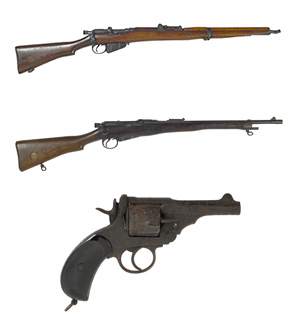Weapons of the Royal Irish Constabulary (1822–1922)
Published in Artefacts, Issue 2 (March/April 2020), Volume 28By Lar Joye

The first police forces in Ireland were created under the Peace Preservation Act of 1814 by Sir Robert Peel (who for three years was MP for Cashel, Co. Tipperary). This was to lead to the creation of county constabularies in 1822, and over the next century 85,000 policemen served. Further restructuring took place in 1836, when the Irish Constabulary was established and became the eyes and ears of the British government in Ireland, maintaining the peace, enforcing the law and helping to collect taxes. They were recruited from the local population, predominantly Roman Catholic, and were billeted in small barracks around the country. For their role in suppressing the Fenian rising of 1867 the constabulary were rewarded with the prefix ‘Royal’ by Queen Victoria. Unlike the police in England, they were armed with revolvers, carbines (a type of shortened rifle) and shotguns. Dublin was policed by the unarmed and smaller Dublin Metropolitan Police (DMP).
By the time of the Irish War of Independence the Royal Irish Constabulary (RIC) was smaller than in the nineteenth century. With a decreased population owing to emigration and the various land acts, the heavy policing of the previous century was no longer necessary. For example, Tipperary in 1871 had 153 barracks compared to 79 in 1911. As the War of Independence continued, resignations from the force increased and in early 1920 it became necessary to recruit from outside Ireland. Most of the new recruits had served in the British army and became known as the ‘Black and Tans’ (see p. 70).
In peaceful times the RIC did not always carry their weapons when on patrol but they were always available at their barracks. The Lee Enfield carbine (left/above) with a six-bullet magazine—as against ten in the larger rifle—was in use by British army cavalry from 1896 to 1907, when it was decided to issue one common rifle to both infantry and cavalry units: the ‘short magazine’ Lee Enfield rifle Mark III (SMLE, right/below).
The RIC’s 10,000 carbines were introduced in 1904 and, notwithstanding the military change, remained in service with the RIC until 1920, when they were replaced by the SMLE. It is believed that the carbine was selected because it was easier to carry on the recently introduced bicycle. The RIC was also equipped with the Winchester model 1897 pump-action shotgun. Unlike the standard sporting model, this version had a short riot barrel. The shotgun, which had a five-round tubular magazine under the barrel, was ideal for dealing with crowds. The handgun used by the RIC was the .445 Webley service revolver (below), which, like all RIC weapons, was marked with an RIC stamp and an individual number. The RIC had adopted its first Webley revolver in 1868, and the weapon was thereafter marketed by Webley to various colonial police forces as the ‘RIC model’.
Lar Joye is Heritage Officer, Dublin Port.
















